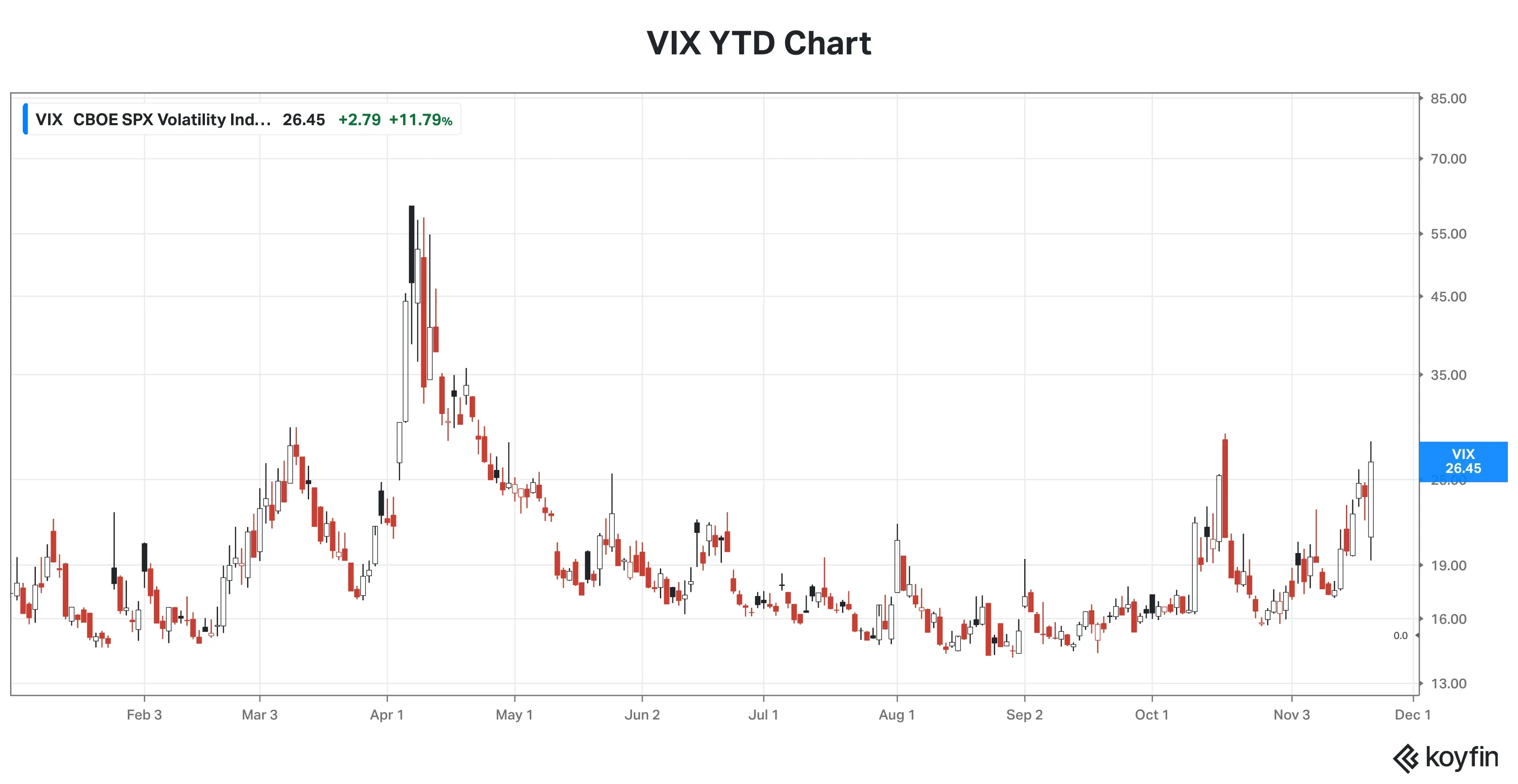Advertisement|Remove ads.
Dow, S&P 500 Futures Tick Higher, But Fear Rules Amid Worst November Since 2008 — Strategists Split On Buying The Dip

- On Thursday, the S&P 500 and the Nasdaq Composite posted the largest intraday reversal since April.
- CNN’s Fear & Greed Index, constructed based on seven different indicators that measure some aspects of stock market behavior, is in “extreme fear territory.”
- Integrated Financial Strategies Chief Market Strategist Roy Mattox said his firm remains in cash.
U.S. stocks appear on track to rebound from their lean patch, with the major index futures rising moderately late Thursday, even as optimism lingered over the bull run . Uncertainty about the trajectory of interest rates and the fate of the artificial intelligence revolution has proved to be undoing of the market in recent sessions, and it would take a resolution for stocks to resume the uptrend and volatility to subside.
The CBOE Volatility Index (VIX), which retreated from the post-tariff announcement highs of over 60 in early April, began to rise in late October. Since a late October bottom of 15.62, the VIX has jumped about 69%.

Source: Koyfin
CNN’s Fear & Greed Index, constructed based on seven different indicators that measure some aspects of stock market behavior, is in “extreme fear territory.”
How Futures Are Trading
As of 11:45 p.m. ET on Thursday, the Nasdaq 100 slipped 0.10%, while the S&P 500 futures climbed 0.20%, and the Dow and Russell 2000 rose about 0.30% each.
On Stocktwits, retail sentiment toward the SPDR S&P 500 ETF (SPY), an exchange-traded fund that tracks the S&P 500 Index, deteriorated to ‘bearish’ as of late Thursday from ‘neutral’ a day ago. The Invesco QQQ Trust (QQQ) ETF, which tracks the Nasdaq 100 Index, saw sentiment dip to ‘neutral’ levels from ‘bullish.’ The message volume on the SPY and QQQ ETF streams remained at ‘high’ levels.
Commenting on the SPY stream, a watcher said the after-hours rebound in the SPY ETF may not mean much. “We all know it's going to be another big red day tomorrow. Bear market blues,” they said. Another is positioned for a “massive collapse.”
Some also weighed in on stocks that will be more exposed to the downslide. “Zombie companies (no revenue, no profit) will have the fastest downturn,” they said.
The view aligned with CNBC Mad Money host Jim Cramer, who posted on social media that he expects an imminent “big shakeout where the real companies with real revenues and real profits will win. But there will not be many of them.”
However, some bulls on Stocktwits said the market could bottom next week, premising the expectations on the Fed lowering rates in December, inflation cooling off in the coming months, and President Donald Trump backing down on tariffs.
How Markets Fared Thursday
Stocks sold off Thursday as early Nvidia-driven optimism fizzled amid fresh worries over the chipmaker’s accounting methods, inventory levels, receivables, and circular deals. Traders also grappled with the delayed September jobs report.
The S&P 500 and Nasdaq Composite logged their biggest intraday reversals since April. The S&P swung 237 points before closing near session lows, while the Nasdaq whipsawed more than 1,100 points.
The sell-off was broad, with IT, consumer discretionary, industrials, and materials hit hardest. Consumer staples were the lone standout, buoyed by Walmart’s guidance hike. Major ETFs slid as well: QQQ fell 2.37%, SPY 1.52%, IWM 1.85%, and DIA 0.84%.
The S&P 500 now sits 5.5% below its Oct. 29 intraday record of 6,920.35. The Nasdaq is down 8% from its 24,019.99 high the same day, while the Dow is 5.5% off its Nov. 12 peak of 48,431.57.
Where’s The Market Headed?
In a post on X, economist David Rosenberg said, “This is probably not a dip you want to buy.” He noted that the S&P 500 took out the 6,550 support flagged by investment strategist Walter Murphy. Thursday’s decline locked in the rally off the April lows as a completed pattern, he said. “A garden-variety retracement of 50% would place the S&P 500 back at the level that it started the year (around 5,900) – more than 10% down from where we are today.”
Integrated Financial Strategies Chief Market Strategist Roy Mattox said his firm remains in cash. “Sometimes the best thing to do is nothing while the bears and the bulls fight it out in [the] grand scheme of things," he added.
BCA Research’s Peter Berezin, a former Goldman analyst, blamed the market pullback squarely on the AI skepticism. Sharing a chart, he noted that hyperscalers will hold at least $2.5 trillion in AI assets by the end of this decade. “Assuming a depreciation rate of 20%, that would generate $500 billion in annual depreciation expense. This is more than their combined profits for 2025.”
On the other hand, Citadel Securities' Scott Rubner called the market pullback, positioning it for a powerful rebound toward 7,000 for the S&P 500 by the year-end, Bloomberg reported. The strategist sees retail investor demand and institutional investors potentially reloading stocks after reducing exposure in the run-up to Thanksgiving as catalysts driving the upside.
Key Catalysts To Watch Out For
S&P is scheduled to release the flash November manufacturing and services purchasing managers’ indices (PMIs) at 9:45 a.m. ET. The University of Michigan would release the final consumer sentiment reading for November at 10 a.m. ET.
The Commerce Department will release the August wholesale inventories at 10 a.m. ET.
Among the Federal Reserve officials speaking during the day are:
-New York Fed’s John Williams (7:30 a.m. ET)
-Boston Fed’s Susan Collins (8 a.m. ET as well as 9 a.m. ET)
-Fed Governor Michael Barr (8:30 a.m. ET)
-Fed Vice Chair Philip Jefferson (8:45 a.m. ET)
-Dallas Fed’s Lorie Logan (9 a.m. ET)
Notable names reporting earnings on Friday are BJ’s Wholesale (BJ) and Buckle (BKE).
How Other Markets Fared
Crude oil futures pulled back further in the Asian session, with the West Texas Intermediate (WTI) grade crude oil now below the $59-a-barrel level. Gold futures also slipped. The 10-year U.S. Treasury note yield fell below 4.1% after dropping 2.7 basis points on Thursday, as the rise in the jobless rate and an increase in weekly jobless claims kept rate-cut hopes alive.
The U.S. Dollar Index held above the 100 mark, with the greenback rising marginally against most major counterparts.
Asian stocks were in a sea of red on Friday, dragged down by Wall Street’s tech-led slump, which deflated the mood. The Taiwanese and South Korean markets, heavily weighted toward tech stocks, slumped by more than 3%, while the Japanese Nikkei 225 average fell by over 2%.
For updates and corrections, email newsroom[at]stocktwits[dot]com.
Read Next: Why Elastic’s Stock Plunged Nearly 13% After-Hours










/filters:format(webp)https://st-everywhere-cms-prod.s3.us-east-1.amazonaws.com/large_House_mortgage_stock_resized_f9fa809f0b.jpg)
/filters:format(webp)https://st-everywhere-cms-prod.s3.us-east-1.amazonaws.com/Sourasis_Bose_Author_Image_939f0c5061.jpg)
/filters:format(webp)https://news.stocktwits-cdn.com/Getty_Images_2239867188_jpg_69d854c89a.webp)
/filters:format(webp)https://news.stocktwits-cdn.com/vivekkrishnanphotography_58_jpg_0e45f66a62.webp)
/filters:format(webp)https://news.stocktwits-cdn.com/large_Getty_Images_2202902434_jpg_34a840ada1.webp)
/filters:format(webp)https://st-everywhere-cms-prod.s3.us-east-1.amazonaws.com/IMG_9209_1_d9c1acde92.jpeg)
/filters:format(webp)https://news.stocktwits-cdn.com/large_Getty_Images_2247687123_jpg_6a66f2327c.webp)
/filters:format(webp)https://news.stocktwits-cdn.com/Aashika_Suresh_Profile_Picture_jpg_2acd6f446c.webp)
/filters:format(webp)https://news.stocktwits-cdn.com/large_Oracle_jpg_7a31f1c69f.webp)
/filters:format(webp)https://st-everywhere-cms-prod.s3.us-east-1.amazonaws.com/Rounak_Author_Image_7607005b05.png)
/filters:format(webp)https://news.stocktwits-cdn.com/large_Trading_Floor_jpg_bfff0c77e9.webp)
/filters:format(webp)https://st-everywhere-cms-prod.s3.us-east-1.amazonaws.com/shanthi_v2_compressed_98c13b83cf.png)